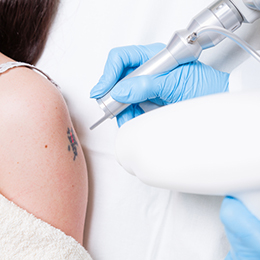Getting a tattoo is no longer a lifetime commitment with the new removal techniques available. During a tattoo, ink permeates the skin to varying degrees. Depending on the color, depth of the needle, and the type of ink used, tattoos can look fresh and vibrant for long periods of time. However, what happens when the ink fades and the customer is left with a faded, blurry unappealing mark? The options are limited to having the tattoo covered, redone, or removed. In this day and age of millennials, blemished skin is no longer an option.
Technology has finally caught up to the way artists “sling ink” for removal. Various fade creams have always touted the ability to help remove or pull out the ink. However, laser removal has advanced to the point that, in most cases, tattoos can be completely removed, but, this option is not without substantial pain and cost.
Nowadays, many companies offer new laser technology from LED to Q-switch. The type of laser used often affects the way the pigment comes out of the skin, as well as the healing time. Lasers are considered to be more effective in removing tattoos permanently. New lasers, such as PicoSure (CynoSure), which use photomechanical or pressure waves technology to break down a tattoo into smaller particles, are claimed to remove tattoos more effectively and in lesser time than compared to Q-switched lasers. Our new report Tattoo Removal Products and Services: U.S. Market Assessment and Opportunities will cover all of these options.
In addition, statistics from ASAPS (American Society for Aesthetic Plastic Surgery) also show the growing popularity of in-office tattoo removal procedures in the United States in 2015. According to ASAPS, about 46,514 tattoo removal procedures were performed in 2015, which is about 40% over 33,363 procedures performed in 2014. In 2015, over two-thirds of tattoo removal procedures are performed on women, mainly among the age-groups of 19-34.
Lasers are not only used to rid skin of tattoo ink. Doctors are seeing a boost in the demand for minimally invasive procedures, including skin resurfacing and rejuvenation, via the use of lasers and injectables. Anti-aging skin concern continues to be a mainstay, as well as the industry’s key growth engine. Aging is the largest skin care concern in terms of sales value and continues to record strong growth driven by new product launches, growing interest from consumers in these products, and the increasing popularity of non-invasive procedures. Manufacturers are formulating their skincare products with retinols and peptides that claim to provide better results.
Dermatologists and plastic surgeons that offer cosmetic procedures using lasers and injectables also dispense skin care products for pre-/post-procedure treatment, as well as for other skin care concerns, such as hyperpigmentation and dehydration. Kline’s forthcoming Physician-dispensed Skin Care: Perception and Satisfaction Survey report will provide insights on what aesthetic physicians value most from their skin care partners, as well as the ratings they give their brands across several attributes, ranging from customer service to clinical-supported skin care products. The aim of this report is to provide an unbiased appraisal of how brands are performing and the areas that may need more focus. To learn more, please contact us.
Written by Sai Swaroop, Project Lead Kline Consumer

